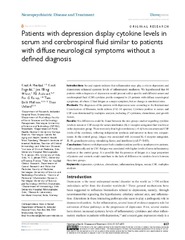Patients with depression display cytokine levels in serum and cerebrospinal fluid similar to patients with diffuse neurological symptoms without a defined diagnosis
Permanent lenke
https://hdl.handle.net/10037/9645Dato
2016-04-13Type
Journal articleTidsskriftartikkel
Peer reviewed
Forfatter
Hestad, Knut A.; Engedal, Knut; Whist, Jon Elling; Aukrust, Pål; Farup, Per Grønaas; Mollnes, Tom Eirik; Ueland, ThorSammendrag
INTRODUCTION: Several reports indicate that inflammation may play a role in depression and demonstrate enhanced systemic levels of inflammatory mediators. We hypothesized that 44 patients with a diagnosis of depression would present with a specific and different serum and cerebrospinal fluid (CSF) cytokine profile compared to 21 patients with diffuse neurological symptoms, of whom 15 had fatigue as a major symptom, but no change in emotional state.
METHODS: The diagnoses of the patients with depression were according to the International Classification of Diseases, tenth edition (F32–34 spectra). Cytokine profiles in serum and CSF were determined by multiplex analysis, including 27 cytokines, chemokines, and growth factors.
RESULTS: No differences could be found between the two groups studied regarding cytokine levels in serum or CSF except for serum interleukin (IL)-1 receptor antagonist that was lower in the depression group. There were only four high correlations (>0.4) between serum and CSF levels of the cytokines, reflecting independent synthesis and turnover in these two compartments. In the control group, fatigue was associated with increased IL-1 receptor antagonist, IL-10, granulocyte-colony stimulating factor, and interferon-γ (all P<0.01).
CONCLUSION: Patients with depression had a similar cytokine profile as nondepressive patients, both systemically and in CSF. Fatigue was associated with higher levels of some inflammatory markers in the control group. It is possible that the presence of fatigue in a large proportion of patients and controls could contribute to the lack of difference in cytokine levels between these two groups.
Beskrivelse
Publisher's version, source: http://dx.doi.org/10.2147/NDT.S101925.
Forlag
Dove Medical PressSitering
Neuropsychiatric Disease and Treatment 2016, 12:817-822Metadata
Vis full innførselSamlinger
Relaterte innførsler
Viser innførsler relatert til tittel, forfatter og emneord.
-
Viridans gruppe streptokokker – inflammatorisk respons i en blodmodell
Broback, Bjørn Martin (Master thesis; Mastergradsoppgave, 2022-05-31)Bakgrunn: Viridans gruppe streptokokker (VGS) er en heterogen gruppe med bakterier som er sett på som opportunistiske bakterier. De har nå blitt en vanligere årsak til alvorlig sepsis hos nyfødte og immunsupprimerte barn. Formålet med denne studien er å sammenligne immunresponsen til en VGS bakterie (Streptococcus mitis) mot en gruppe B streptokokk (GBS) og Staphylococcus haemolyticus i en ex vivo ... -
Prognostic Impacts of Angiopoietins in NSCLC Tumor Cells and Stroma : VEGF-A Impact Is Strongly Associated with Ang-2
Andersen, Sigve; Dønnem, Tom; Al-Shibli, Khalid Ibrahim; Al-Saad, Samer; Stenvold, Helge; Busund, Lill-Tove; Bremnes, Roy M. (Journal article; Tidsskriftartikkel; Peer reviewed, 2011)Angiopoietins and their receptor Tie-2 are, in concert with VEGF-A, key mediators in angiogenesis. This study evaluates the prognostic impact of all known human angiopoietins (Ang-1, Ang-2 and Ang-4) and their receptor Tie-2, as well as their relation to the prognostic expression of VEGF-A. 335 unselected stage I-IIIA NSCLC-patients were included and tissue samples of respective tumor cells and ... -
The Temporomandibular Joint in Juvenile Idiopathic Arthritis, focusing on Quality of Life, Oral Microbiome and Intervention
Frid, Paula (Doctoral thesis; Doktorgradsavhandling, 2020-10-02)The temporomandibular joint (TMJ) is commonly involved in juvenile idiopathic arthritis (JIA), and may lead to impaired mouth opening, pain and facial growth disturbances. Asymptomatic TMJ arthritis may be diagnosed late in the disease course, thus management is challenging. The overall objectives of this thesis were to provide new knowledge on quality of life (QoL), the oral microbiome and interventions ...


 English
English norsk
norsk


